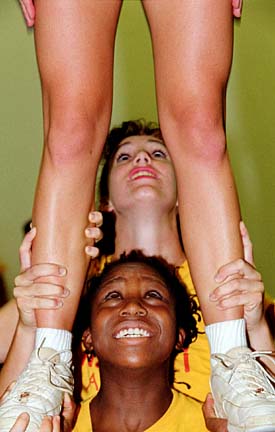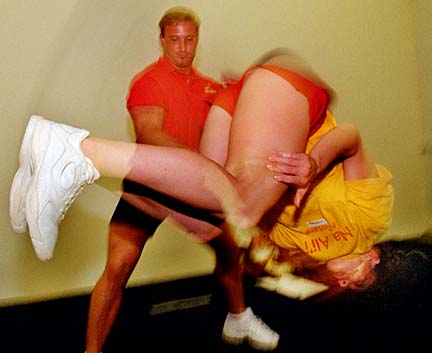Advertisement - Click to support our sponsors.



THERE is no cheering in cheerleading.
Cheerleaders prove their
athleticism; 'It's not
sissy or la-la'By Cynthia Oi
Star-BulletinAt least not at the Hawaii Cheer Co. gym on this humid afternoon. There's a lot of jumping, tumbling, twisting, flipping, tossing, catching and popping, a lot of grunting, a lot of sweating and a whole lot of enthusiasm.
About three dozen teen-agers clad in bright yellow T-shirts and red shorts are practicing their routines, but this is not your mother's satin-skirted, lei-wearing cheerleading.
Today, cheerleading is more about strength and stamina. These kids do more than look good; they display an athleticism usually found in traditional sports.
"If cheerleading was any easier, we'd call it football," said Robert Daniel, owner, director and chief instructor of Hawaii Cheer. "It's not sissy or la-la. We're hardcore athletes."
Cheerleading no longer exists solely on the sidelines of the football field. It has grown as a sport itself with more than 600,000 young people in the United States participating.
It has become fodder for Hollywood with two recent movies -- "Bring It On," and "But I'm a Cheerleader" -- on the big screen.

Two bodies, the National Cheerleaders Association and the Universal Cheerleaders Association, dominate the industry called spirit leading, an overall term that covers cheerleading and dance teams.Nationwide competitions, training camps, uniform and equipment sales and televised performances are all part of the enterprise.
Neither NCA nor UCA will say how much money the industry generates, but judging from the number of products, camps, catalogs and Web sites, it's big.
Or as Daniel said, "It's huge, HUUUGE!"
In Hawaii, cheerleading has grown by leaps and bounds. So much so that the Oahu Interscholastic Association will hold its first championship next year.
Keith Amemiya, executive director of the Hawaii High School Athletic Association, hopes Hawaii will soon have a statewide championship with squads from the Neighbor Islands, the OIA and the Interscholastic League of Honolulu.

Cheerleading is "not like when I was in high school," Amemiya said. "It's not just make a pyramid, wave pompons and that's it. It's more like sports."You don't have to tell the kids at the gym.
Nalani Anderson, a 15-year-old Pearl City High student, finds herself fit and strong although she's only been cheering for a year.
"I used to die when I walked up a hill or something. Now I can really move."
"You have to be in shape to do this," says Iwalani Yamauchi, 16, a three-year varsity cheerleader at Kaimuki High.
Although the girls are on their school squads, they also do all-star cheering, teams that aren't affiliated with schools. With all-star teams, "go, team, go" cheers are secondary to synchronized movement to music.
"It doesn't mean that they're all stars like in baseball," Daniel said. "It means they are among the elite in cheerleading."
Hawaii Cheer's Na Alii All Stars consists of about 100 girls and boys.
Daniel has watched Hawaii Cheer's influence widen significantly since he started his company in Pearl City about five years ago.
"We work with 80 percent of the high schools (squads) in Hawaii," he said.
Last year, Na Alii's senior team placed fourth in the NCA championship in Dallas. Two of Na Alii's members were among the four chosen from a group of 650 young people from around the country to staff NCA, Daniel said.
Aiea High's team was national champion in the small coed division and Damien's squad was third in the parochial division. Hawaii Cheer helped coach both schools.
"That was really rewarding," he said.
Cheerleading can be an expensive undertaking, Daniel said. At Hawaii Cheer, a one-hour class costs $5; all-star members pay $2.50. Uniforms can run $200 or more, but he keeps the cost down by choosing the less expensive outfits.
"If you let the kids choose, they'll probably choose the most expensive one," he laughed.
But the costs are secondary to most cheer parents.
Terri Cass said she's pleased her two daughters, Kimberly, 15, and Brittany, 11, are involved.
"It keeps them active and doing something healthy. They enjoy it and it gives them self-confidence, self-esteem," she said.
"My kids are military kids so this gives them exposure to local kids. They get to mix with everybody," she said.
"They love it. They'd live at the gym if they could," she said.
Deborah Carter thinks cheerleading not only keeps her daughter Yolanda healthy, but gives the 16-year-old an outlet.
"Not many organized sports are this expressive. Cheerleading gives her a chance to do that," Carter said.
Many of the cheerleaders also participate in other sports.
Megan Worthley, 15, a varsity cheerleader at Iolani, is on the school's diving team. Brian Gipson, 18, a Radford High School cheerleader, runs track and plays on the basketball team. Jason Shane Dela Cruz, 17, of Damien played football.
Gipson and Dela Cruz acknowledge that males are a minority in cheerleading.
"There's a stereotype about guys cheerleading, but it's not, like, mahu. You gotta be tough, strong," said Dela Cruz.
"It builds your strength, stamina," said Dain Azumi, 17, of Aiea High, who used to play soccer, practice judo and wrestled. "You got to be physical."
Daniel, 30, bristles at the image that some may have about male cheerleaders being feminine and female cheerleaders being sexually promiscuous.
"The guys act like guys. This is about athleticism, not asses," he said. "These kids bust their butts to be the best."
Pearl City's Anderson is a good example. She trains two to three hours, three days a week at Hawaii Cheer. She also works out with the school squad, putting in a total of 18 to 20 hours a week training.
It's not all hard work.
"Kids are living, breathing, fun machines," Daniel said.
Gipson cheers for fun but also for his future.
Because he is small, he doesn't believe he can get a track or basketball scholarship but he is sure he can get one for cheerleading.
Many colleges and universities offer partial or full scholarships to cheerleaders. Azumi has already been approached by the University of Oklahoma and one of Hawaii Cheer's instructors is on full scholarship at Hawaii Pacific University.
"Six years of my schooling was paid for by scholarships," said Daniel, who attended the University of Kentucky and University of Hawaii.
Anderson finds that cheerleading helps her organize her time better.
"It keeps me motivated to study, too, because if I don't keep up my grades, I can't cheer."
"You learn a lot not just about cheering, but about yourself, your limits, your strengths," said Dela Cruz.
Worthley said cheerleading builds mental toughness.
"You prepare yourself to accept disappointment, but you work hard for success. You make mistakes, but you get over them."
Daniel, who doesn't allow the kids to get too emotional about winning and losing, tries to keep competition in perspective.
"You can cry when someone you love is sick or dying, when something really bad happens," he said.
"But there's no crying in cheerleading, not in our squad."
Click for online
calendars and events.